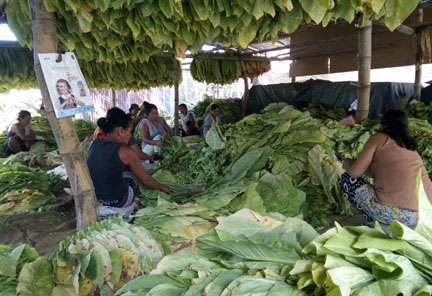News Articles
Tobacco Production: THE ILOCANO FAMILY'S LIFELINE
 |
TOBACCO as the major cash crop of the Ilocos region has an undeniable impact on the agricultural, economic, and social life of every Ilocano family, and has been a major force in the economic development of Ilocos especially Region I where flue-cured or Virginia tobacco is grown.
It is little wonder that the tobacco, a major industry in the region that survived the Spanish and American colonial period, represents the Ilocano, the way pinakbet does for regional dish, "Manang Biday" for folk song, bucanegan and "Biag ni Lam-ang" for literature, and saluyot for leafy vegetable.
The widespread influence of tobacco on the Ilocano families, particularly in the last quarter of the preceding century, was one of the main points of discussion at the "Ilocano" episode of the "Wika ng Ina Mo" radio program of DZUP 1602 (campus radio) in UP Diliman, Quezon City. Our Deputy Administrator for Operations Atty. Mel John I. Verzosa and I were invited as resource persons during the program aired live on June 8.
Program hosts Glecy Atienza and Camille Pajarillo facilitated the one-hour discussion of the Ilocano episode which centers on the tobacco industry. The other episodes for the month dealt on the Ilocano language and literature, and Ilocano orthography.
Atty. Verzosa and I were glad to discuss tobacco growing families and we even had the opportunity to dispel some misconceptions on tobacco. There were lots of discussion on the industry, but what intrigued non-Ilocanos like Ms Atienza, which is the highlight of this article, is on how the Ilocano family got involved in tobacco production and how the industry has influenced the Ilocano way of life through the years.
Think of the Virginia tobacco and be reminded of the numerous Ilocano farming families who have derived a big bulk of their farming income and livelihood from the industry for many decades since the 50s, the reason the golden leaf industry continues to thrive in the region despite continuing anti-tobacco lobbies and other efforts to curb tobacco production and smoking.
The concentration of tobacco production in Ilocos started in the 50s after an American tobacco firm found out that the soil and climate in the region were good for Virginia or flue-cured tobacco. The Ilocanos then were more than willing to embrace tobacco production because the crops were grown during summer when most of their unirrigated land would lay idle after rice production.
Most farmers in the region, unlike those in the Central Luzon and some regions in Mindanao, own smaller land areas and usually unirrigated, thus giving them a very limited annual income from farming. With tobacco, they were given the opportunity to earn more than what they get from their usual rice-corn cropping rotation. Even without the capital for production, some middlemen or leaf buyers handily loaned the farmers some amount which would be paid after the trading season.
Compared with other crops, tobacco needs more attention and care, and follows strict standards and technology to produce quality leaves that the market requires. But to produce highly priced quality tobacco leaves, a tobacco grower needs patience, diligence and hardwork, which are trademark characteristics of the Ilocano.
Members of the Ilocano family work together for this labor-intensive yet lucrative farming venture. A big part of tobacco production including post-harvest activities is mostly done during summer where the children are having their long school break. So every member of the family, including school-age children help in the farm during this period of production. The father and the elder children are responsible for the production, from seedbedding to the gathering of leaves, construction of curing barns, and loading of tobacco leaves in sticks/strings into the barn. And during harvest and curing period, everyone, including the children and some helpful neighbors, join in the sticking, and later, sorting of leaves. The women usually join their husbands in selling their produce in the trading center.
Are the Ilocanos promoting cigarette smoking? Do all Ilocanos smoke, as one way of patronizing their own product? No and no. The character of Gloria Romero's iconic movie "Manang Biday" where she brandished an oversized pinadis (rolled native tobacco) borders more on theatrics than realism and does not represent the Ilocano women, generally. Not all Ilocanos get into smoking, which some of them consider it as a choice rather than a vice. To the Ilocanos, the tobacco is just an agricultural crop where they can earn big income, especially during summer. There may be health hazards in tobacco production, but this has been addressed by the agency and private contractors with the application of Good Agricultural Practices in the tobacco farming communities.
Tobacco trading usually falls in as early as February up to the last week of May, so the farmers can have the money to celebrate the fiesta of their patrons that are held mostly in the said period, and they have the money in time for the school enrolment in June, and capital for rice production in the ensuing season.
Ilocanos born in the 60s towards the 80s in the farming communities know how tobacco farming has helped most Ilocanos raise a family and send their children to school. Most of these children have become professionals, teachers, lawyers, doctors, and writers. The money was also spent to send members of the family to work abroad as contract workers. Think how these individuals who were successful in their careers and work, contributed to the improvement of the economic condition in their communities.
The number of farmers and hectarage may have dwindled through the years, but the income of farmers per hectare of tobacco remains high. But unlike before, farmers now are given production assistance to subsidize production cost, thus giving them more returns of investment. It also helped that the NTA has eliminated the cowboy system, or trading through intermediaries, and lowered loan interest, which contributed to the reduction of production cost to the advantage of the tobacco growers.
Some farmers who returned to tobacco claimed that the crops they produce other than tobacco yielded very little. Some who shifted to corn production went back to tobacco only after a year or two because they do not have market for corn and they do not receive government assistance, unlike in tobacco production.
It also helped that the local governments are keen to continue their support for tobacco farming for the billions of revenues it brings. The Sin Tax Law generates enormous revenue, in the form of excise taxes, for the national treasury, P3.65 billion in 2017, which the government uses for its education, infrastructure, economic, health and welfare programs all over the country. A part of the excise tax collection is appropriated to beneficiary Virginia tobacco growing provinces, pursuant to R.A. 7171; and, Burley and Native Tobacco growing provinces, pursuant to R.A. 8240.
With the economic benefits redounding to the benefit of the families in the Ilocos region, some farmers will not see themselves leaving tobacco production anytime soon. This I have to explain to Ms Atienza, that in the absence of viable alternative crop for tobacco, the industry remains to be the family's lifeline of some Ilocanos. (Neyo E. Valdez)






